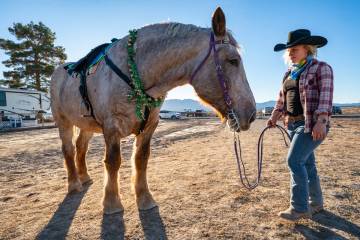Water looms as key issue for Nevada Legislature
CARSON CITY — State lawmakers got a crash course Tuesday on Nevada’s complicated water laws as they prepare to consider several bills dealing with the most precious resource in the driest state in the nation.
State Engineer Jason King, whose office has proposed four bills this session, said more proposed laws are expected, including one to address Nevada’s long-standing doctrine of “use it or lose it.”
He also tried to dispel concerns by domestic well owners that his office wants to take away domestic well rights.
“That couldn’t be further from the truth,” King told a joint meeting of the Senate and Assembly natural resource committees.
But the state’s more than a century-old water law is based on the principle of “first in time, first in right,” meaning the holders of the state’s oldest water rights are first to get their allotments if curtailments become necessary in times of drought or overly-stressed groundwater basins.
Roughly 20 percent of the 256 groundwater basins in Nevada considered “severely overappropriated,” meaning there’s more water appropriated on paper than is available.
Domestic well owners are allowed 2 acre-feet annually. But most appropriated wells are “junior” in priority, meaning under existing law they could be subject to being cut off if a severe water problem occurs.
If a situation develops where groundwater levels plummet, “the statute provides that our office shall go in and regulate by priority,” King said. That would entail setting a cutoff date on when water rights or wells were drilled to determine who gets water and who doesn’t.
Nevada’s wet winter may alleviate immediate water and drought concerns, but officials said the state cannot be complacent in planning for a return of dry years.
Nevada is the driest state in the nation, and its total water resources involve about 2 million acre-feet of groundwater and 4.7 million acre-feet of surface water. That is about the same volume that flows through Dalles on the Columbia River in 19 days, King said.
An acre-foot is about 326,000 gallons, or enough water to supply two families of four for a year.
Pahrump’s Basin 162 is one of the most overappropriated basins across the state. The Pahrump Valley has close to 60,000 acre feet of paper water rights and over 11,000 existing domestic wells, the largest concentration in Nevada. Yet most of the wells are junior in priority to water rights in the valley.
The valley also has approximately 20,000 acre feet of recharge.
The Nevada Division of Water Resources’ data showed that water level is rising on the alluvial fans and in their vicinity, but there’s a steady decline to the west and south on the valley floor.
The Nye County Water District estimated that the valley lost about a foot of water per year from 2004 to 2014. Meanwhile, on the alluvial fan, the recovery was a foot of water per year in the same years.
Pahrump Valley Times reporter Daria Sokolova contributed to this story.

















